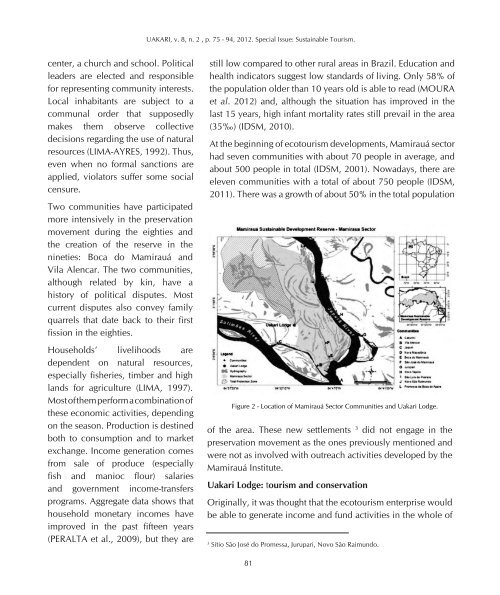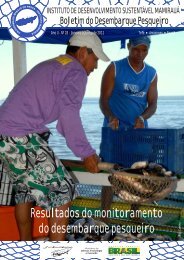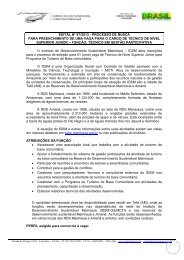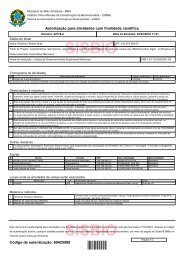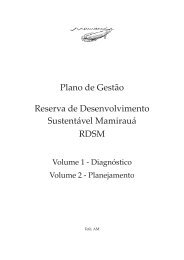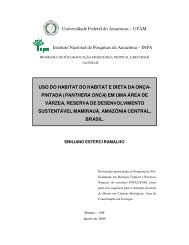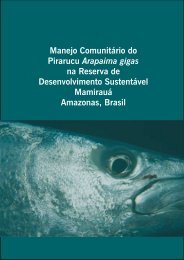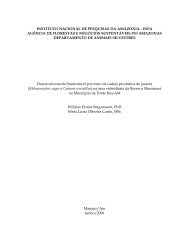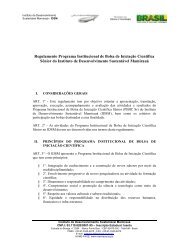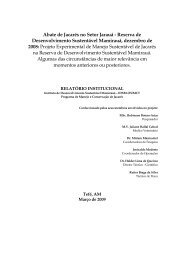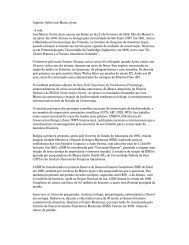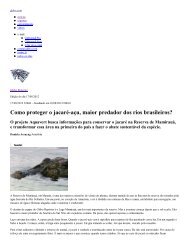PERALTA, N. Ecotourism as an incentive to biodiversity conservation.politically in<strong>de</strong>pen<strong>de</strong>nt communities. Prior to that,people were <strong>de</strong>pen<strong>de</strong>nt on a <strong>de</strong>bt-bondage systemof patronage locally known as aviamento (LIMA-AYRES, 1992). When rural commerce <strong>de</strong>clinedand patrons moved to urban towns, settlementswere scattered along rivers and channels. Duringthe seventies, due to a rise in productivity of thefisheries industry and <strong>de</strong>cline of stocks near urbancities, like Manaus and Itacoatiara, large vesselsnavigated upriver to <strong>de</strong>plete stocks on which thesecommunities’ livelihoods <strong>de</strong>pen<strong>de</strong>d on (DERICKX,1992). With the support of local Catholic Church,these communities created a management system,which divi<strong>de</strong>d lakes in different categories –preservation, subsistence and free lakes. The firsttwo types were to be protected by members ofthe communities from exploitation of outsi<strong>de</strong>rs;the latter was allocated to the commercial fishingsector. As the Movement lacked legal basis,all preservation efforts like the zoning system,apprehension of poachers’ materials, etc. werechallenged by local political elites (REIS, 2005;PERALTA, 2002). The partnership with researchersfor the creation of the Reserve in 1990, gave theprotection of the area an official, legal status.The challenge afterwards was to create a strategythat would enable local peoples to inhabit thearea and use its resources sustainably. A Non-Governmental Organization (NGO) was createdin 1992 to manage human and financial resources<strong>de</strong>dicated to the implementation of the protectedarea – Socieda<strong>de</strong> Civil Mamirauá (SCM) 2 – whichwas granted co-management of the area by theAmazonas State.During the early nineties researchers and locallea<strong>de</strong>rs set out to elaborate and agree upon azoning system and set of norms for the use of2In 1999 another institution was created and later qualified as apublic utility by the fe<strong>de</strong>ral government: the Mamirauá Institute forSustainable Development.natural resources. In 1996, they achieved thisobjective, publishing a management plan. Thezoning system <strong>de</strong>stined a core area as a totallyprotected zone, where human settlements and useof natural resources were prohibited. Surroundingthis core area a sustainable use zone, where mostof the settlements were located and economicproductive activities could be carried out. Theassignment of a protection zone with restrictionsfor productive use was regar<strong>de</strong>d as a cost forlocal communities, which would bear economiclosses resulting from the restrictions imposed bythe management plan (SCM, 1996). Thus, a set ofalternative income activities were also proposedin the management plan, among them, fisheriesmanagement, forest management and ecotourism.Economic activities which will,concomitantly, diverge the <strong>de</strong>mand pressureon natural resources locally threatened,or maintain it un<strong>de</strong>r control, and,complementarily, raise household income(…) preferably of those inhabitants mostaffected by the limitations of the norms ofuse of this management plan (SCM, 1996).An ecotourism enterprise was planned to be<strong>de</strong>veloped in Mamirauá sector, within the totallyprotected zone near the Mamirauá Lake – an areasubject to pressure from large fishing vessels thatwould extract tons of fish at a time.Mamirauá sector: sociopolitical and economicsettingsCommunities are local settlements of peoplerelated by kin, with about 10 households in average.They have been established with the support ofthe local Catholic Church. They usually comprisesome basic infrastructure such as a community80
<strong>UAKARI</strong>, v. 8, n. 2 , p. 75 - 94, 2012. Special Issue: Sustainable Tourism.center, a church and school. Politicallea<strong>de</strong>rs are elected and responsiblefor representing community interests.Local inhabitants are subject to acommunal or<strong>de</strong>r that supposedlymakes them observe collective<strong>de</strong>cisions regarding the use of naturalresources (LIMA-AYRES, 1992). Thus,even when no formal sanctions areapplied, violators suffer some socialcensure.Two communities have participatedmore intensively in the preservationmovement during the eighties andthe creation of the reserve in thenineties: Boca do Mamirauá andVila Alencar. The two communities,although related by kin, have ahistory of political disputes. Mostcurrent disputes also convey familyquarrels that date back to their firstfission in the eighties.Households’ livelihoods are<strong>de</strong>pen<strong>de</strong>nt on natural resources,especially fisheries, timber and highlands for agriculture (LIMA, 1997).Most of them perform a combination ofthese economic activities, <strong>de</strong>pendingon the season. Production is <strong>de</strong>stinedboth to consumption and to marketexchange. Income generation comesfrom sale of produce (especiallyfish and manioc flour) salariesand government income-transfersprograms. Aggregate data shows thathousehold monetary incomes haveimproved in the past fifteen years(PERALTA et al., 2009), but they arestill low compared to other rural areas in Brazil. Education andhealth indicators suggest low standards of living. Only 58% ofthe population ol<strong>de</strong>r than 10 years old is able to read (MOURAet al. 2012) and, although the situation has improved in thelast 15 years, high infant mortality rates still prevail in the area(35‰) (IDSM, 2010).At the beginning of ecotourism <strong>de</strong>velopments, Mamirauá sectorhad seven communities with about 70 people in average, andabout 500 people in total (IDSM, 2001). Nowadays, there areeleven communities with a total of about 750 people (IDSM,2011). There was a growth of about 50% in the total populationFigure 2 - Location of Mamirauá Sector Communities and Uakari Lodge.of the area. These new settlements 3 did not engage in thepreservation movement as the ones previously mentioned andwere not as involved with outreach activities <strong>de</strong>veloped by theMamirauá Institute.Uakari Lodge: tourism and conservationOriginally, it was thought that the ecotourism enterprise wouldbe able to generate income and fund activities in the whole of3Sítio São José do Promessa, Jurupari, Novo São Raimundo.81
- Page 1 and 2:
ISSN 1981-450XUAKARIv.8 n.2 dez. 20
- Page 3 and 4:
AddressInstituto de Desenvolvimento
- Page 5 and 6:
Journal was designed with the goal
- Page 7:
ASSESSING THE MARKET FOR ECOTOURISM
- Page 10 and 11:
JaNéR, A. Assessing the Market for
- Page 14 and 15:
JaNéR, A. Assessing the Market for
- Page 16 and 17:
JaNéR, A. Assessing the Market for
- Page 18 and 19:
JaNéR, A. Assessing the Market for
- Page 21 and 22:
UAKARI, v. 8, n. 2 , p. 7 - 25, 201
- Page 23 and 24:
UAKARI, v. 8, n. 2 , p. 7 - 25, 201
- Page 25 and 26:
UAKARI, v. 8, n. 2 , p. 7 - 25, 201
- Page 27 and 28: ENVIRONMENTAL IMPACT ASSESSMENT OF
- Page 29 and 30: UAKARI, v. 8, n. 2 , p. 29 - 42, 20
- Page 31 and 32: UAKARI, v. 8, n. 2 , p. 29 - 42, 20
- Page 33 and 34: UAKARI, v. 8, n. 2 , p. 29 - 42, 20
- Page 35 and 36: UAKARI, v. 8, n. 2 , p. 29 - 42, 20
- Page 37 and 38: UAKARI, v. 8, n. 2 , p. 29 - 42, 20
- Page 39 and 40: UAKARI, v. 8, n. 2 , p. 29 - 42, 20
- Page 41 and 42: DOES ECOTOURISM ACTIVITY AFFECT PRI
- Page 43 and 44: UAKARI, v. 8, n. 2 , p. 43 - 50, 20
- Page 45 and 46: UAKARI, v. 8, n. 2 , p. 43 - 50, 20
- Page 47 and 48: UAKARI, v. 8, n. 2 , p. 43 - 50, 20
- Page 49 and 50: BIRDWATCHING IN THE MAMIRAUÁ LAKE
- Page 51 and 52: UAKARI, v. 8, n. 2 , p. 51 - 66, 20
- Page 53 and 54: UAKARI, v. 8, n. 2 , p. 51 - 66, 20
- Page 55 and 56: UAKARI, v. 8, n. 2 , p. 51 - 66, 20
- Page 57 and 58: UAKARI, v. 8, n. 2 , p. 51 - 66, 20
- Page 59 and 60: UAKARI, v. 8, n. 2 , p. 51 - 66, 20
- Page 61 and 62: UAKARI, v. 8, n. 2 , p. 51 - 66, 20
- Page 63 and 64: UAKARI, v. 8, n. 2 , p. 51 - 66, 20
- Page 65 and 66: REPERCUSSIONS OF THE 2010 EXTREME D
- Page 67 and 68: UAKARI, v. 8, n. 2 , p. 67 - 74, 20
- Page 69 and 70: UAKARI, v. 8, n. 2 , p. 67 - 74, 20
- Page 71 and 72: UAKARI, v. 8, n. 2 , p. 67 - 74, 20
- Page 73 and 74: ECOTOURISM AS AN INCENTIVE TO BIODI
- Page 75 and 76: UAKARI, v. 8, n. 2 , p. 75 - 94, 20
- Page 77: UAKARI, v. 8, n. 2 , p. 75 - 94, 20
- Page 81 and 82: UAKARI, v. 8, n. 2 , p. 75 - 94, 20
- Page 83 and 84: UAKARI, v. 8, n. 2 , p. 75 - 94, 20
- Page 85 and 86: UAKARI, v. 8, n. 2 , p. 75 - 94, 20
- Page 87 and 88: UAKARI, v. 8, n. 2 , p. 75 - 94, 20
- Page 89 and 90: UAKARI, v. 8, n. 2 , p. 75 - 94, 20
- Page 91 and 92: UAKARI, v. 8, n. 2 , p. 75 - 94, 20
- Page 93 and 94: OZORIO, R. Z.; JANÉR, A. Community
- Page 95 and 96: OZORIO, R. Z.; JANÉR, A. Community
- Page 97 and 98: OZORIO, R. Z.; JANÉR, A. Community
- Page 99 and 100: OZORIO, R. Z.; JANÉR, A. Community
- Page 101 and 102: OZORIO, R. Z.; JANÉR, A. Community
- Page 103 and 104: OZORIO, R. Z.; JANÉR, A. Community
- Page 105 and 106: OZORIO, R. Z.; JANÉR, A. Community
- Page 107 and 108: OZORIO, R. Z.; JANÉR, A. Community
- Page 109 and 110: OZORIO, R. Z.; JANÉR, A. Community
- Page 111 and 112: OZORIO, R. Z.; JANÉR, A. Community
- Page 113 and 114: UAKARI - Guidelines for publication
- Page 115 and 116: UAKARI - Guidelines for publication
- Page 117 and 118: UAKARI - Guidelines for publication
- Page 119 and 120: UAKARI - Guidelines for publication
- Page 121: Editorial 3 - 4Review ArticlesAsses


